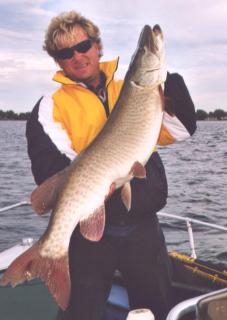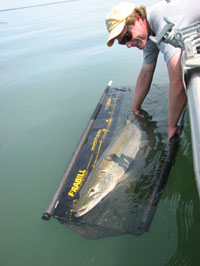
The effects of competitive fishing on natural resources and fish populations are major areas of concern, in my opinion. Various factors can impact the health and survival of a muskellunge population during a competitive fishing event, including the fish handling techniques used by the competing anglers, the nature of the competition itself, and any diseases or invasive species that might be introduced to the lake during the event. The effects on tourism and the local economy must also be examined. I have many concerns about such events, most of which I discuss here. I am open-minded on the issue, but my worries lie in the long-term impact of these events. I do believe competitive anglers share the same passion for the sport as we do, but I am not sure how much our resources can take given the stress they currently experience. Keep in mind that our wild muskellunge population propagates itself through natural reproduction.
Human Impact
Fish Handling
Where do you turn to establish a proper method of handling fish? Several landing methods exist. Net, cradle, and hand landing seem to be the most prevalent, with some use of Bogas. No two individuals handle fish in the same way, and several factors come into play when determining how a fish is handled. The fish’s intentions and disposition are not always understood. Some anglers, if not most, are intimidated by the fish and the lures imbedded in it. I fear that trying to establish one method for everyone could be beyond reach. Where do we get the information to propose and back such a universal method? Even if this is accomplished, how can we get 100 participants to have the same confidence when handling the species when prior experience among them varies from one extreme to another? Given this variation, the potential for delayed mortality could possibly increase if a competitive event was to take place at a time when certain activity factors would play a great role in capture rates. Regulating such methods may cause more problems than benefits. Essentially, who has the knowledge to propose such a universal method? Once again, the interpretation of benefits is left open to scrutiny. Enforcement of the regulations would be left to interpretation at the discretion and judgement of a conservation officer.
Guides and Charters
We are comparing two different types of practices here. I do believe that those earning a living from the resource should contribute to sustain their means. Many do by volunteering and donating. Some don’t, and this choice is the responsibility of the individual. The operators should also consider spreading their impact on their resource; once again, this is an individual responsibility. Many times the resources are close to the hearts of these operators.
Size Restrictions and Trophy Waters
We have made much progress in attempts to protect these unique fisheries. In many cases, size restrictions have been increased to 54 inches with others at 48 and 50 inches, with intentions of protecting wild reproducing stocks. Should competitive events be permitted on such waters? If so, what is the purpose of implementing a protective size limit but possibly allowing the targeting of sub-legal fish? How do you regulate events which take sub-legal fish into accountability? Given the low density and potential spawning success rates on these protected fisheries, what impact could these events have over time? Competitive events on trophy waters seem to go against the established philosophy of strategic trophy-class management.
Environmental Concerns
Natural Resources
The lake itself is something we all value for the enjoyment it provides. We must take into consideration our forefathers’ success at preserving and conserving this resource. It is important that we continue to preserve this enjoyment for future generations. So many factors impact our resource and its ecosystem that we should err on the side of caution and assess the potential harm or impact of our actions. Should we not pride ourselves in having wild, naturally reproducing populations?
Invasive Species
Many do not consider this matter, but the introduction of invasive species is at high levels. Disease and microorganisms are introduced into our fisheries every year. Tournaments could potentially draw participants from many different regions, so we should be concerned about introducing foreign organisms into certain fisheries. So little is known about diseases and invasive species that caution should be taken and thought must be given to the potential impact. Lice, red spot, lympho or any other disease or foreign species could negatively impact a given body of water not accustomed to having such matter introduced into its ecosystem. What impact could invasive species like gobies and, in some regions, pike cause to resident populations not accustomed to such an intrusive presence?

Biology
Understanding the biological makeup of the species is important when understanding its reaction to various factors. Stress levels vary from one individual to another, an uncontrollable situation when trying to harmonize or standardize release methods. Water temperature and levels greatly influence the survivability of muskellunge. Tendencies and success rates vary from year to year. The variables that control their success at survival after spawning impact the potential regeneration of wild stocks. Given their low survivability rate and, in some areas, low density, we must be concerned about their sustainability. Average water temperatures have risen in the past few years, and we should be concerned about what impact that may have on survivability rates and what stresses it will place on our naturally reproducing fisheries. Environmental impacts weigh much on our populations with habitat restrictions, pleasure boating, water quality, and conditions. Our fisheries are evolving. How will this change the impact on our populations over time?
Affects on Local Tourism
Direct Economic Impact by Competitive Events
The true economic impact of competitive fishing events on the area in which it is held must be examined. Would the participants favor financially moderate accommodations, or would they prefer resort or lodging-type accommodations? If a decline is shown or a delayed mortality issue arises, the cost of correcting this and maintaining the health of the resource in the future must be assessed. The size of the economic impact on the community generated by 100 or so event participants must be measured as well. Where would the funds to maintain and assess the situation come from? Will the economic benefits outweigh the potential negative impact on naturally reproducing populations?
Indirect Economic Impact and Local Tourism
The impact on local tourism must be considered, considering that most tourists are vacationing when an event is taking place. There must be a careful consideration of benefits versus costs, especially since tourists who reserve vacations for tranquility and peace may not enjoy such events. A competitive fishing event in a certain area could mean that they would book later dates or choose to vacation elsewhere. Lodges in certain areas of the U.S. have noticed dips in tourist activity due to such events. What real financial gain can be raised by 100 competitors? Spectator attendance is sometimes less than the amount of actual participants.
The irony of all of this is that on one hand, we are trying to reintroduce a population of muskellunge in hopes of the species naturally sustaining itself in the years to come and setting an example for North America. On the other hand, we must try to find ways to benefit from those populations that show signs of stability.
For More Information
I recommend the Competitive Fishing in Ontario Workshop proceedings of March 12-13, 1999, and also “Competitive Fishing in Freshwaters of North America: A Survey of Canadian and U.S. Jurisdictions.” Another good read is the 1999 Survey of Competitive Fishing in Ontario, which includes some good biological information about spawning habits and survivability, stress potentially induced by angling practices, fish handling methods, and other concerns.
Conclusion
I suspect that the preservation and conservation of the wild naturally reproducing populations is of utmost importance to muskie anglers, and I question whether competitive events have a positive or negative impact on our naturally reproducing fisheries. However, what concerns me most is that there are no regulations in place to protect the restriction of such events with little or no knowledge of their potential impact on current muskellunge populations. In a way, these unanswered questions lead me to be more apprehensive and protective of our natural resources.
We must continue on the path that our forefathers and ministry have led us down. Through conservation, preservation and natural propagation of the species, the experience of such a wonderful and unique resource will be ensured for future generations. In many cases, we do not know what we have until we no longer have it.










